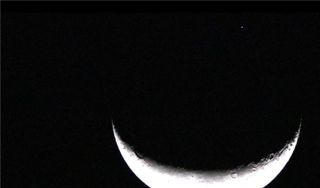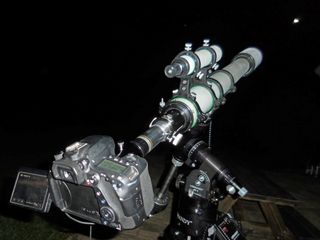Peekaboo! See the Bright Star Regulus 'Hide' Behind the Moon This Saturday
This Saturday (Nov. 11), the bright star Regulus will briefly disappear behind the last-quarter moon, providing a treat for skywatchers across North and Central America.
This will be the second time in less than a month that this particular star has appeared to pass behind the moon in the sky, in an event known as a lunar occultation. On the morning of Oct. 15, Regulus spent up to 70 minutes behind the moon from our perspective on Earth. But Regulus isn't the only bright star to have spent some time lurking behind the moon lately — last Sunday (Nov. 5), the nearly full moon also occulted the orange star Aldebaran.
While the last two occultations coincided with dark skies, Saturday's occultation of Regulus will happen after sunrise. This means that it will be a bit more difficult to see and photograph. However, skywatchers who are lucky enough to experience clear skies that morning will get a rare, blue backdrop for the celestial sight. [Best Night Sky Events of November 2017 (Stargazing Maps)]

The recent trifecta of major, back-to-back lunar occultations has been a rare treat for astrophotographers like Victor Rogus, an amateur astronomer and Fellow of the Royal Astronomical Society, who captured spectacular photos and videos of Regulus playing "peekaboo" with the moon last month.
"I decided to put my antique, 3-inch Unitron refractor to work and see if I could make a video of the occultation of the magnitude 1.4 star Regulus," Rogus told Space.com in an email. "It was amazing to see Regulus pop out from behind the moon as dawn arrived."

The start and end times of any occultation — when the star disappears behind one limb of the moon and reappears from behind the other — varies by location. The timetable below offers a few examples of start and end times for Saturday's occultation of Regulus as seen from major cities along the path of visibility. For a more detailed list and a viewing map, check out this lunar occultation page by the International Occultation Timing Association.
Regulus will first disappear behind the moon for viewers in Japan, at about 11:46 p.m. local time (1446 GMT). However, the moon will be so close to the horizon that it may be difficult to see. Skywatchers in the Western Hemisphere will have a better view of the occultation, albeit in brighter skies as the sun continues to rise.
Get the Space.com Newsletter
Breaking space news, the latest updates on rocket launches, skywatching events and more!
| Location | Disappears | Reappears |
| Anchorage, Alaska. | 7:07 a.m. | 7:25 a.m. |
| Vancouver, B.C. | 8:39 a.m. | 9:14 a.m. |
| Los Angeles | 8:51 a.m. | 10:00 a.m. |
| Denver | 10:15 a.m. | 10:45 a.m. |
| Houston | 11:29 a.m. | 12:14 p.m. |
| Memphis, Tenn. | 11:39 a.m. | 11:53 a.m. |
| Savannah, Ga. | 12:46 p.m. | 12:58 p.m. |
| Tampa, Fla. | 12:40 p.m. | 1:15 p.m. |
| Mexico City | 11:34 a.m. | 12:35 p.m. |
| Guatemala City | 11:44 a.m. | 12:42 p.m. |
The sun may be high in the sky during the occultation, but the moon won't set below the horizon until early in the afternoon. To find out precisely where and when the sun and the moon will rise and set, check out this handy astronomy tool at timeanddate.com.
After Saturday's occultation, the next stellar event like this will occur on Dec. 3, when the "supermoon" occults Aldebaran once more for viewers in northeast Asia, Alaska and northwest Canada.
Editor's note: If you have an amazing night-sky photo you'd like to share with us and our news partners for a possible story or image gallery, send images and comments to spacephotos@space.com.
Email Hanneke Weitering at hweitering@space.com or follow her @hannekescience. Follow us @Spacedotcom, Facebook and Google+. Original article on Space.com.
Join our Space Forums to keep talking space on the latest missions, night sky and more! And if you have a news tip, correction or comment, let us know at: community@space.com.

Hanneke Weitering is a multimedia journalist in the Pacific Northwest reporting on the future of aviation at FutureFlight.aero and Aviation International News and was previously the Editor for Spaceflight and Astronomy news here at Space.com. As an editor with over 10 years of experience in science journalism she has previously written for Scholastic Classroom Magazines, MedPage Today and The Joint Institute for Computational Sciences at Oak Ridge National Laboratory. After studying physics at the University of Tennessee in her hometown of Knoxville, she earned her graduate degree in Science, Health and Environmental Reporting (SHERP) from New York University. Hanneke joined the Space.com team in 2016 as a staff writer and producer, covering topics including spaceflight and astronomy. She currently lives in Seattle, home of the Space Needle, with her cat and two snakes. In her spare time, Hanneke enjoys exploring the Rocky Mountains, basking in nature and looking for dark skies to gaze at the cosmos.
